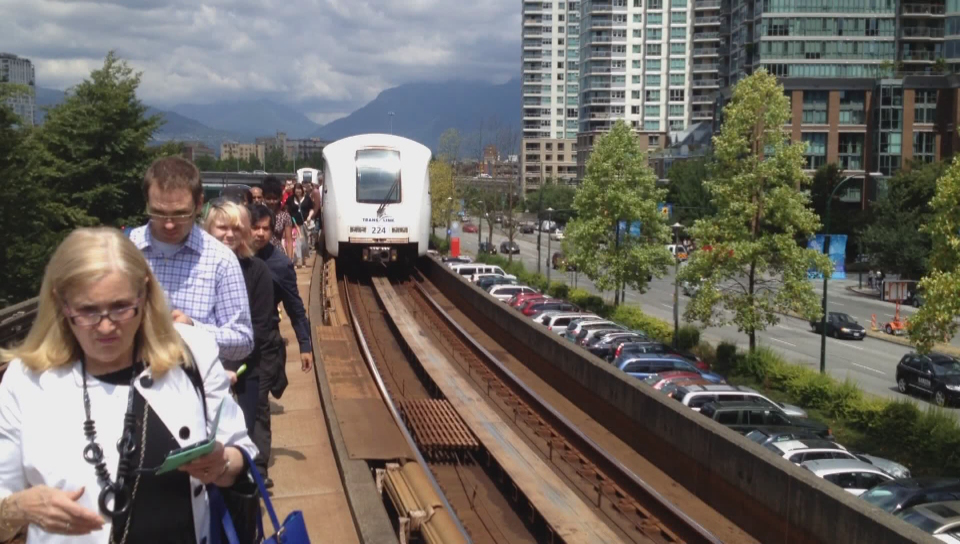Today TransLink released an independent review into two major disruptions of the entire Skytrain system during the summer.

The review, written by longtime transportation executive Gary McNeil, looks at why the Skytrain lines failed and what can be done to ensure future shutdowns don’t last for hours.
READ: The full report is at the bottom of our main story
TransLink says it will adopt all 20 recommendations of the report, which will cost $71 million and take five years to fully implement.
But what does it actually mean?
We combed through the report to find five facts you need to know.
1) Much of the problem stemmed from not paying for an auto-restart system
If TransLink’s system shuts down, every single train has to be manually introduced back into the computer system. Each train takes 5-10 minutes to get back on line, so it takes 3-5 hours for the system to fully recover – even if people stay in the trains. If they don’t, as was the case during several shutdowns in the last six months, the problem can be exacerbated.
There is an auto-restart module available for the technology, but TransLink opted not to pay for it when the system was last upgraded 20 years ago. And while TransLink is currently looking at upgrading their system again, adding the auto-restart module wasn’t being considered.
That is, until this report. McNeil recommends “TransLink expedite investigation of the auto vehicle re-start feature,” which will cost $5 million and take three years to implement.
2) TransLink says it has to communicate better
Six of the recommendations centre around “Improvements to Customer Service and Communication”, including increasing the visibility of frontline staff (a nominal cost), the quality of the PA system (a $15 million cost), and the number of signboards and speakers at all stations (a $15 million cost).
Perhaps most damning was the fact most bus drivers weren’t aware of the SkyTrain shutdown and continued to send people to stations that were overcrowded, adding to the problem.
“Direct communication to customers during these service disruptions was inadequate and limited,” concludes the report, a charge TransLink CEO Ian Jarvis accepted today.
“We need to get better at responding and getting our customers tended to,” he said.
“We clearly failed our customers back in July. Let’s make certain we tend to those trains in a more timely way.”
3) There are plenty of smaller issues that have to be improved
McNeil’s report found that TransLink is particularly vulnerable to a number of possible failures. These include:
- There’s currently only one power feed going into their main yard in Burnaby, the “heart and brains” of SkyTrain.
- Troubleshooting guidelines and maintenance manuals haven’t been updated in decades, and “new hires do not have the same level of experience and knowledge of the specific SkyTrain system elements.”
- Work is allowed to be done on system-critical components during peak hours.
- There’s no Asset Management Plan to document infrastructure
READ MORE: TransLink blamed the July disruptions on a computer glitch
4) TransLink wants you to know it’s still a good system
McNeil’s report contained a section favourably comparing TransLink to other rapid-transit systems around the world.

The report also points out that TransLink has kept on-time performance at a high level as the system has grown.

It was a point Jarvis repeated when speaking to the media today, but he acknowledged that most people don’t compare TransLink to other systems, but to their previous experiences on TransLink itself.
5) TransLink could be asking for more money sooner rather than later
One thing McNeil makes clear several times in the report is that Translink cannot avoid future shutdowns – it can only hope to deal with them in a more efficient manner.
Another thing that’s clear is there will be more, not less, requests for additional funding in the future.
From page 35 of the report:
“The present operating budget has to deal with:
- A four-fold increase in passengers
- A four-fold increase in kilometres driven by the trains
- 30 year old fleet and infrastructure, and
- high expectations from the public on customer service.
SkyTrain needs more operating dollars to serve their growing passenger base.”
McNeil’s report is the first comprehensive look at how SkyTrain can maintain the public’s confidence as it enters middle age. It won’t be the last.
WATCH: Transit blogger Nathan Pachal talks about the independent review of the SkyTrain service disruptions in July.




Comments